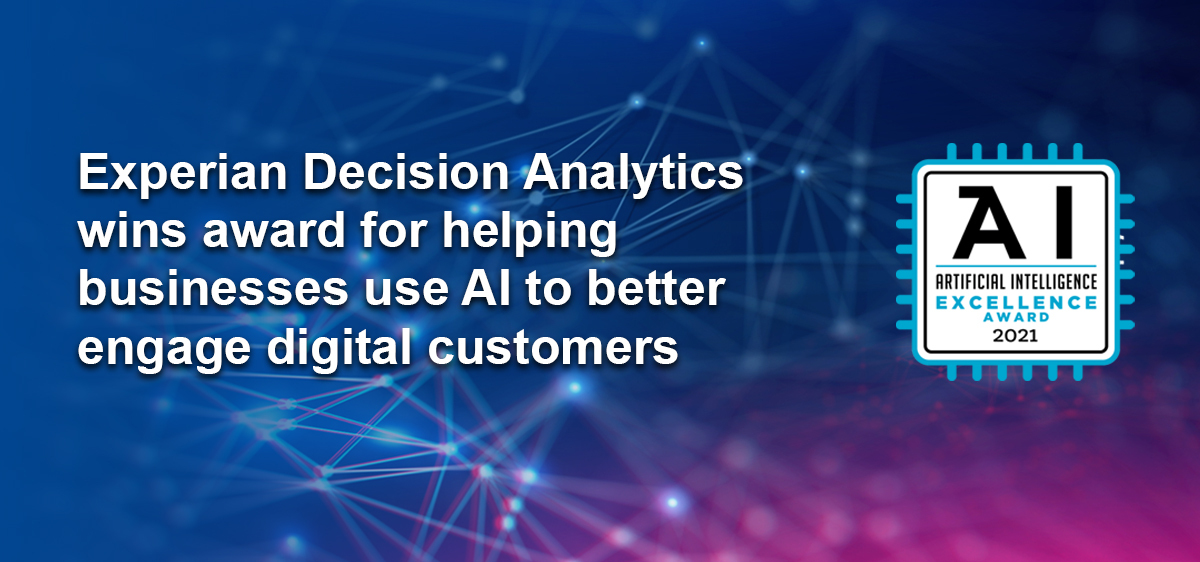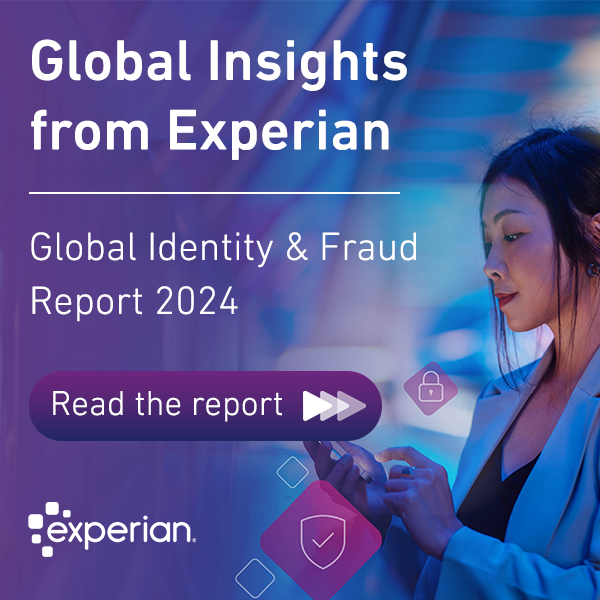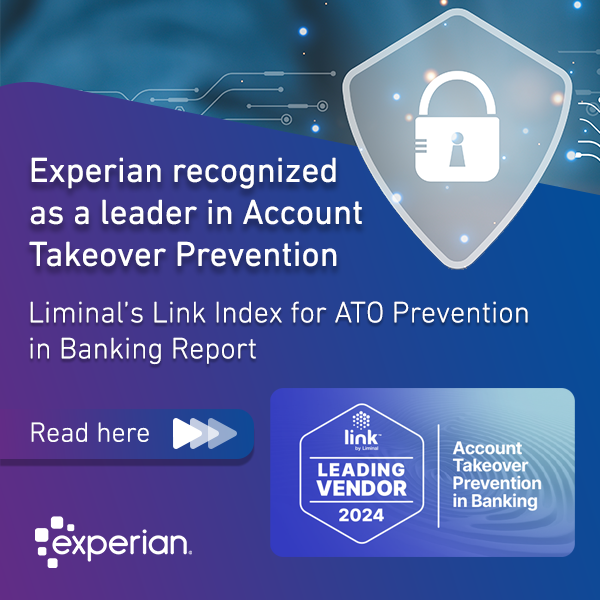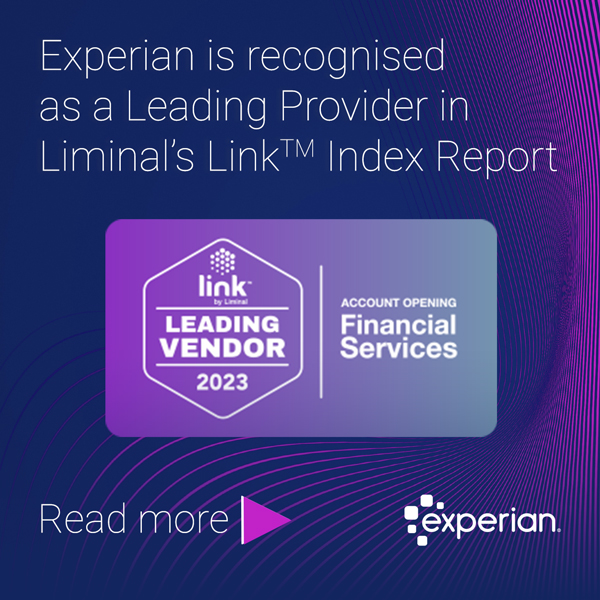Search Results for: DATA AI

Did you miss these March business headlines? We’ve compiled the top global news stories that you need to stay in-the-know on the latest hot topics and insights from our experts. How to build consumer trust without sacrificing the experience This Forbes article explores the relationship between brand trust and customer experience using the lastest research from Experian. Read about how simple verification methods, personalization and ensuring the use of robust ethical data practices, can be key to driving consumer trust. Using AI for digital identification, fraud prevention, and increased ROI In this IOT for all article, Eric Haller, Vice President & General Manager of Identity, Fraud & DataLabs, covers how investing in AI will not only improve customer experience but also impact a company's bottom line. Digital and online trends in a post-pandemic world Nasdaq #TradeTalks Video Broadcast Series featuring Steve Wagner, Global Managing Director of Decision Analytics, covers what we should expect to see from consumers and businesses in a 2021 post-pandemic world when it comes to digital and online. How current data-driven digital identity impacts businesses and consumers 60 percent of consumers are using a universal mobile wallet to make digital payments according to Experian's latest research. Eric Haller, Vice President & General Manager of Identity, Fraud & DataLabs, talks to CNP about how digital identity solutions that use AI and ML will reduce fraud and improve customer experience when it comes to digital transactions. The sophisticated customer and the need for adaption This Q&A in the Digital Journal with Donna DePasquale, Vice President & General Manager of Global Decisioning, looks at how businesses should respond to consumers seeking a better online experience. Stay in the know with our latest insights:

Experian is honored to be recognized as a winner of the Artificial Intelligence AI Excellence Award by Business Intelligence Group. Experian was recognized for its credit and collections decisioning solution, PowerCurve, which features intelligent agent-customer assist that processes complex, regulated, and subjective interactions with customers, revolutionizing how they digitally interact, on their terms, with lenders. This AI virtual assistant offers customers 24/7 access to support from their credit provider - on a financially sensitive transaction such as collections. We embedded over 30 years of collections knowledge and experience delivered to major clients across the globe into a credit risk decision management solution that delivers this domain expertise, data, analytics, decisioning, and workflow to clients of all sizes via cloud technology. Harnessing the power of AI has enabled lenders to easily connect with customers on their terms in a fair and transparent way, and to recover losses in an operationally efficient way but also improve customer satisfaction. When’s the last time you heard a customer share a positive story about collections? This digital self-service channel allows customers to engage with a lender on their terms and allows the lender to fulfill key objectives for quickly recovering losses, using the company’s strategic parameters for segmentation and treatment paths. The intelligent agent customer-assist feature within PowerCurve continuously learns which distinguishes it from the traditional decision-tree structure of a chatbot. It remembers interactions and learns from them, has short-term and long-term conversation goals, and recognizes small talk. It treats customers fairly and transparently. The result feels more empathetic and allows for an always-on and real-time consumer interaction. It can also offer a future-forward benefit to lenders, by allowing their employees to strategically focus on other areas of the business, potentially increasing the capacity for more credit products and services innovation. This Business Intelligence Group awards program sets out to recognize those organizations, products and people who bring Artificial Intelligence (AI) to life and apply it to solve real problems. Related stories: Going the last mile: Improving the End-to-End Digital Customer Journey Technology today: Focus on innovation drives award-winning, AI-powered consumer lending Podcast: Driving product vision with the customer front and center, a software architect’s view

Given market dynamics, technology today is an important topic for businesses to track — whether beginning a technology transformation journey or looking to continuously improve by understanding the latest advancements available — including AI-powered consumer lending. With innovation at the forefront of practices, our experts help power important topics around this subject — and fuel breakthrough technologies. Recently, this focus on innovation was acknowledged, with Ascend Intelligence Services™, winning both honors from The CIO 100 Awards and The FinTech Breakthrough Awards, premiere and notable programs that recognize breakthrough technology worldwide. ML technology helps drive customer satisfaction and increased bookings The CIO 100 Awards recognized Atlas Credit, a midsized lender headquartered in Texas for their use of the Experian Ascend Intelligence Platform. The platform enabled them to double loan application acceptance rates while reducing credit losses by up to 20 percent. Atlas Credit uses the tools and data to make instant decisions, resulting in improved customer satisfaction and higher booking rates. Using Ascend Intelligence Services, Experian data scientists rapidly built a machine learning (ML) custom credit risk model, optimized a decision strategy, and deployed the model in production, reducing time to impact by six months. “Winners are chosen by a team of external judges, many of them former CIOs, on their use of leading-edge IT practices that produce measurable results. The award is an acknowledged mark of enterprise excellence. This year's honorees exemplify what it means to deliver business value through the innovative use of technology. This elite group is creating competitive advantage in their organizations, improving business processes, enabling growth and improving relationships with customers," according to CIO 100 2021 winners. The CIO 100 awards are presented by IDG's CIO — the executive-level IT media brand providing insight into business technology leadership, each year, CIO recognizes the premier organizations and executives driving IT innovation with these prestigious awards. Honorees are inspiring examples of how IT leadership, business partnerships, and customer engagement are reshaping the future. Atlas Credit was the recipient of the Optimal Loan Underwriting with Machine Learning for Underserved Consumers project. Better results, delivered faster to help power FinTech evolution Experian's Ascend Intelligence Services was also selected as a winner of The FinTech Breakthrough Honors, which recognizes Standout FinTech Companies and Solutions in 2021. Ascend Intelligence Services was recognized as the FinTech Breakthrough Award winner in the Consumer Lending Innovation Award category. The FinTech Breakthrough Awards is the premier awards program founded to recognize the FinTech innovators, leaders, and visionaries from around the world in a range of categories, including Digital Banking, Personal Finance, Lending, Payments, Wealth Management, Investments, RegTech, InsurTech, and many more. The 2021 FinTech Breakthrough Award program attracted more than 3,850 nominations from across the globe. "This past year has been unlike any time period ever seen before for FinTech growth and disruption, with FinTechs maturing to become respected, global players throughout the financial services value chain," said James Johnson, Managing Director, FinTech Breakthrough. "FinTech is a digital force that has clearly entered a new phase of its evolution, moving out of niche use cases to operate at scale, and we are thrilled to recognize the 'breakthrough' FinTech innovators in this market evolution for our fifth annual FinTech Breakthrough Awards program." Ascend Intelligence Services is a fully managed analytics service delivered digitally by Experian data scientists. It helps lenders leverage advanced technology, utilizing AI to deliver better results up to 5x faster, accelerating time-to-market all while allowing them to make sound business decisions. Related stories: Insights in Action Podcast: Identifying the core capabilities your business needs to get MLOps right Fair and explainable artificial intelligence is accelerating industry transformation Going the last mile: Improving the End-to-End Digital Customer Journey

Artificial Intelligence (AI) offers people and companies many advantages, and we interact with it every day. From the technology we use to do simple things like heating and cooling our homes, to more advanced tools that map potential disease outbreaks across the globe. AI is also being used more and more in the financial services sector – from matching new customers with the right loan and terms to assisting with transactions in real-time online. In a recent study, we found two-thirds of businesses surveyed globally are using AI to help manage their businesses today. More businesses are keen to use AI but are challenged to fulfill requirements for decision explainability – a must-do for ensuring consumers are treated fairly. The history of AI AI stems from the realization of the potential of computation. The father of theoretical computer science and AI, Alan Turing, introduced a theoretical mathematical model of computation – aptly named the Turing Machine – in 1936. He described this machine as being capable of computing anything computable. By 1950, his work posed the question “Can machines think?” He introduced the Turing Test, still in use today to subjectively evaluate whether a machine is intelligent based on its ability to have a conversation. Six years later, in 1956, prominent computer scientists proposed the famous Dartmouth Summer Project. Advanced concepts were introduced and discussed and the term "artificial intelligence" was first coined. Over the following two decades, AI flourished. Computers became not only faster, cheaper, and more accessible, but they were progressively able to store more information. Meanwhile, machine learning algorithms continued to improve, getting the interest of experts in different fields and industries and taking the realm of artificial intelligence to a tipping point in the early ’80s. Back then, John Hopfield and David Rumelhart popularized “deep learning” techniques which allowed computers to learn from experience. Meanwhile, Edward Feigenbaum introduced expert systems which mimicked the decision-making process of a human expert, allowing the program to ask an expert in a field how to respond in a given situation and to learn from it. How can AI benefit both businesses and consumers? Following these early milestones, the advanced analytics sector has experienced explosive growth – with AI impacting many aspects of our lives today. While most people have come to realize that AI can be beneficial, even since the early days, there have been many different views on how those involved in programming the algorithms must take the necessary steps to prevent AI from reinforcing stereotypes, widening wealth and educational gaps, or providing incorrect answers at critical junctures such as in a medical setting. As an example of what not to do: a famous language model was trained using 8 million pages sourced directly from the web. So, implicit in this model are the preconceptions and biases included in its training data. In this case, it led to a model with a trend towards greater male bias in more senior, higher-paying jobs. How to determine fairness in AI models So how can we ensure that the use of AI does not reinforce societal racism, sexism, or other stereotypes? That leads us to define fairness. It’s the impartial and just treatment of people without favoritism or discrimination; when no unjustified distinctions occur based on groups, classes, or other categories to which they are perceived to belong. But, within the world of AI, there are varying approaches to fairness associated with different metrics to evaluate and adopt this sought-after algorithmic fairness. Any solution requires defining dimensions of fairness, but realistically, it’s extremely hard to capture all these very sensitive variables and risky to store and process them. To truly determine if an AI system is fair requires an enormous amount of data and expertise. Additionally, promoting fairness requires an approach across the entire data science life cycle and modeling life cycle. All areas must be considered from the approach to data collection to ongoing evaluation of decisions. And, while fairness in AI is not ‘once and done’ or easily solved, the good news is that it is an area of great focus for regulators, academics, and data and analytics industry experts, like our peers at Experian. The growing importance of transparency and explainability Models generally compute calculations that are complex and involve more dimensions than we can directly comprehend. Given this processing step from model-input-to-model-output is unclear, it leads to questions around how a model has come to a decision. Importantly, how can one be sure that the model is behaving as expected? There are different ways to address explainability. One includes an understanding of how different inputs of a model affect its outputs. Shapley values, introduced by Nobel prize winner Lloyd Shapely, consider an aggregate of marginal contributions for all possible combinations. Another technique involves explaining the behavior of a decision by identifying model constants verse variables to extract what drove a decision and how. Yet another method uses counterfactual explanations, identifying the precise boundary where a decision changes. This method is easy to communicate since it involves statements such as if X had not occurred, Y would not have happened. As in the case of fairness, there’s an on-going dialogue around explainability, underpinned by current and yet to emerge new techniques that maintain model accuracy and improve explainability. Artificial intelligence is past its infancy stage. It’s already had an impact on our daily lives and is becoming increasingly ubiquitous. Fairness, along with a transparent and explainable approach are key ingredients to help this field continue its transition to maturity.

In a world drastically and constantly changing, industries and technologies are being transformed at a rate never before experienced. Recently, I had the opportunity to speak with Roy Schulte, Distinguished VP Analyst at Gartner, about trends in the evolving world of big data, advanced analytics, and decision intelligence — trends that are powered by advancements in cloud technology, machine learning, and real-time streaming. Below, I will share a summary of key highlights. The growth of decision management More businesses are implementing decision management. They want to make more automated decisions to accelerate outcomes while improving applicability. In tandem, decisions are becoming more complicated with regulators increasingly expecting decisions to be explainable and with audit trails built-in. Equally, the combination of machine learning and decision management has placed greater focus on the importance of avoiding bias. Bringing all of this together promises continuous decision improvement; updating models and strategies in days or even hours rather than weeks and months. Essential in responding to the rapidly changing environments, none more so than the impact of Covid-19. As businesses are implementing decision management, they are putting the new systems into the cloud. Based on a Gartner survey in mid-2020, 67% of respondents said their digital business platform will be cloud-native application architecture. It’s the primary criteria for the architecture of many of these new systems. Migrating to the cloud The reason decision management is going to the cloud is the same reason other areas of business are taking this step. Organizations are highly motivated not to run their own systems. There is no competitive advantage to doing so. They want to entrust it to others so they can focus on what the business does best. The migration will continue gradually to the cloud, with a current acceleration based on Covid-19. In a recent Gartner survey, 65% of respondents said the pandemic accelerated their plans and funding for doing digital business. Most models and strategies will be built in the cloud, and the actual runtime decisions will be distributed with some on the cloud, some on-premise in a data center, and some out in the edge in a mobile device. Real-time streaming In the past, traditional business information was done on static, snaps of data from the past. Today, much of this is going real-time, depending on the kind of decision that is being made. For example, when a customer is visiting a website, there are mere seconds to generate the next best offer. This is a real-time decision. However, some decisions do not require real-time, such as the strategic decision to acquire another company or not. That is why it’s important to align the decision speed and cadence with the actual business problem. If real-time data will be used, such as for an e-commerce situation, some of it must be streaming data. With the increase in factors taken into account when making decisions, you need data that is connected, contextual and continuous. The data must come for your entire ecosystem, not a single department, but across your company, business partners, your customers, or market data. Streaming examples for e-commerce might include location, what the person has been doing on the web recently (clickstreams), and records of contact with your business such as calls and emails. A real-time lookup is involved with inventory and external factors like credit rating through an API, and customer data will include historical and real-time. With these factors, real-time decisions for e-commerce will be more effective, with higher yield rates and lower fraud rates. Machine learning in model building and execution Machine learning (ML) is making predictions, not decisions. When a prediction is made and a score is provided, a rule must be applied to determine outcomes based on the score. If considering rules or analytics, the truth is that in most cases, both are needed. The goal of ML in decision management is to have applications that are easier to develop, faster to develop, and lead to more accurate outcomes. To achieve this objective, a process covering all stages of a decision cycle is needed — Observe: Getting connected, contextual, continuous intelligence. Governance is key at this step to know where data is coming from and that it will be used in authorized ways. ML models and strategies must avoid bias and alternative data sources and lending criteria should be considered to expand the business without incurring increased risk. Orient: The next step is putting the data in context. When dealing with models at scale, it’s important to be able to track outcomes through tools such as performance dashboards. Eventually, this will lead to the hyper-personalization of models. Decide: Once models are built, strategy, rule authoring, and approvals are needed. Workflow and collaboration mechanisms help manage the process and accelerate the pace of developing new decisions. Act: Next comes the deployment of models. Using logic to make decisions across multiple applications accelerates deployment, often referred to as centralized management or reuse of decision factors. Feedback: Finally, continuous logging of decisions and effects of decisions. Tracking provides the ability to audit past decisions, explain what was done, and accurately post hoc remediate. Ongoing feedback also enables continuous decision improvement at an accelerated pace. The future of decision management includes decision intelligence In summary, there are five considerations for the future of decision management — A systematic approach to decision making, including a lot more automation and decision intelligence, is clearly on its way. Migration to the cloud is well underway with acceleration thanks to Covid-19. Equilibrium will be reached where some decisions are made at run time at other locations, but most of the development of decision-making, modeling, and strategies will be based on cloud platforms. Data science ML vendors have not focused on decisions. Some may come to realize the reason you do analytics is decisions and broaden the scope of what they do, or they may stay focused and instead partner with other vendors to enable end-to-end decision making. For certain kinds of logic, graph databases and graph analytics can be very powerful. Likely this will become a big part of decision intelligence going forward. Finally, there is huge untapped potential in optimization technology to improve decisions either at development time or even at run time by applying optimization techniques. This could lead to achieving the full vision of artificial intelligence. Related stories Insights in Action Podcast: Identifying the core capabilities your business needs to get MLOps right New Tech Talks Daily Podcast: Machine learning and AI in business — investment trends pre- and post-pandemic In digital transformation, small wins lead to big outcomes

Get the latest from our global experts with these top December headlines, including meeting the demand for digital, increasing consumer expectations, women leading artificial intelligence, and protecting against fraudsters over the holiday shopping season. Investment priorities to meet consumer demand for digital banking In this BAI Banking article, Chris Fletcher, SVP Decision Management & Cloud Services, explores the investment required of financial institutions to transform their use of data and analytics and deliver on credit risk strategies. What’s the proper path for better payments? In context to consumers’ digital expectations post-Covid-19, Progressive Grocer considers the future of payments in food retail and beyond – with contactless payment options already rolling out at a large drug store chain. Wisdom from the women leading the AI industry, with Laura Stoddart of Experian Authority Magazine speaks with Laura Stoddart, Data Scientist, about her career path, her experiences working on ethical AI and using emerging datasets to evaluate risk as well as her thoughts on the future of this industry. #TradeTalks: Increasing consumer demands and expectations Steve Wagner, Global Managing Director of Decision Analytics, joins Nasdaq’s Jill Malandrino to discuss recent research findings on increasing consumer demands and digital expectations, and ongoing considerations for a post-Covid-19 world. A holiday season like no other: What to know to guard your company against fraud Itay Levy, Forbes Councils member and CEO and Co-Founder of Identiq, provides his perspective on the increased preference for online shopping and the need to strike the right balance between customer experience and efforts to mitigate fraud. Stay in the know with our latest insights:

In this Tech Talks Daily podcast, Shri Santhanam, Executive Vice President and General Manager of Global Analytics and AI, speaks with podcaster Neil C. Hughes. Santhanam discusses trends based on data from our recent Global Insights Report, which found that nearly 70% of businesses have used either machine learning or AI in business management and almost 60% of businesses are increasing their budget for analytics and customer creditworthiness in the next 12 months. Here are highlights from this 21-minute podcast: Covid-19 disruption has become a catalyst for breaking largely mindset-based transformation barriers, leading to unprecedented digital disruption and adoption of advanced technologies Experian global research confirms a fundamental change in the way businesses and consumers think about digital adoption and experiences Businesses will continue to increase budgets to grow data science resources to align their intent with their capacity Consumers have high expectations and little patience through their digital engagements, with 1/3 of customers only willing to wait 30 secs or less before abandoning an online transaction The greatest success from analytics and AI in business is realized when teams are focused and agile in their approach Listen now: Get more insights from these podcasts featuring Shri Santhanam: New Podcast from AI in Business: The evolution of the data business in the age of AI What is the right approach to AI and analytics for your business? Four fundamental considerations Forbes Podcast: Looking to Data, Analytics and AI to plan the way forward

Consumer demand has shaped the way businesses worldwide have adjusted or intend to adjust operations and investments throughout the pandemic. Businesses that have struggled to meet the new expectations of consumers will need to meet ever-changing conditions with careful investment and data-driven analyses. Experian’s latest Global Insights Report shows two-thirds of consumers globally have remained loyal to their favorite brands during the pandemic. Brand loyalty was found to be the highest in India, at 80%, and lowest in France, with a bit more than half, at 57%. However, loyalty may not be a given going forward. Competitive differentiation is founded on how you engage customers, at every interaction. Our research shows that loyalty is intrinsically linked to trust, security and convenience. Payment system providers, such as PayPal, have retained the top spot for customer loyalty for three years in a row, but there continues to be movement among the remaining top five industries. This fluctuation, indicative of consumer preferences and behaviors, is fueled by the varying speed at which businesses globally are transforming front- and back-end systems. Particularly, this holds true for the pace of digitization of credit risk and fraud risk operations. Leverage data to retain loyalty Consumers have higher expectations than ever before, and businesses need to meet or exceed these expectations by adapting to correlate with the dynamic nature of the customer journey throughout the continuing pandemic. The report also found that 60% of people have higher expectations of their digital experience than before Covid-19, increasing the need for businesses to make sure that they are leveraging data to benefit their customers, providing secure and convenient digital experiences. Although most customers have shifted to digital and prefer the conveniences of online, mobile and contactless transactions, concerns over data security remain. In response, businesses need to carefully navigate customer experiences to ease apprehension. A great example is the trust, and therefore loyalty, that can be established by using customer data for identity authentication. Customers gain protection while enjoying a hassle-free experience that is non-threatening and transparent. Some businesses recognize these needs, with 40% reporting they are doing a better job communicating how customer data is used to enhance the customer experience, protect consumer information and personalize products and services. Integrating data, analytics and technology Our survey also found that only 24% of businesses are deliberately making changes to their digital customer journey. However, many of them have intentions of making changes and are increasing their budgets in order to do so. Three of the top five solutions businesses are using to help improve the customer journey are designed for driving insights into faster customer decisions. Of these top five solutions, the use of AI to improve customer decisions ranks first amongst banks, payment providers, and retailers ranks first. Companies who are, or plan to, accelerate the implementation of AI can make faster, smarter data-driven decisions to better serve consumers. The key to better serving customers lies in a business’s ability to integrate data and decisioning technology to deliver fast and relevant products and services. In fact, the study found that one in three consumers are only willing to wait 30 seconds or less before abandoning an online transaction, including accessing their bank accounts. With such a short window to keep the customer engaged, faster decision making is imperative to not only retaining a customer’s loyalty on a long-term basis but getting them to commit to a transaction once. Businesses, particularly retailers and financial services who implement the necessary technologies will help move economies from sustainability mode towards a future of growth but cannot do so without continued consumer demand. While customer loyalty does remain, it is up to businesses to adapt and accommodate to retain, and potentially increase the impact of these adjustments. Regardless of where they’re transacting, consumers expect a secure, convenient experience—and they’ll quickly abandon transactions if they’re let down. So, businesses must keep their focus on transformation. Discover more insights from our longitudinal study of the impact of Covid-19 on businesses and consumers.

The relationship with artificial intelligence may have started with robots but its integration into the way people interact with the world today looks very different. AI is in our pockets, our homes, our workplaces, and its pay-off is being realized across many industries, including financial services, e-commerce, telecommunications, streaming services, insurance companies, and more. Though some people and businesses still have reservations about its use. In the next article in our “Game Changers: Women in AI” series, we examine the artificial intelligence debate with arguments against and for its use in our everyday lives, and how it can bring real value to our interactions with businesses – whether it’s preventing fraud, increasing financial accessibility, enhancing the digital experience or supporting public initiatives to prevent the spread of Covid-19. Q: What is your view on criticism of AI or arguments against its use? He: "AI is already all around us and sometimes people don’t even realize it. For example, smart devices remember your preferences, try to understand your behaviors, and help you with reminders, goals, or some other alert. For some, this can feel a little bit scary, like they are collecting information and profiling you. But really, AI is helping people by using large amounts of data to train models and find patterns in the information to solve complicated problems." Kazmi: "Since AI is still so new, every time a product or a change in experience through AI is introduced, there are bound to be reluctancy in adoption and initial failures which lead to opposition. But, to establish the final best product possible, we need understanding between AI research teams and business stakeholders. Take the example of Elon Musk. He has come up with SpaceX and Tesla, but there have been so many failures in their development. Still, the entire world was looking up to these ventures, because these products are something that's going to bring huge positive change." Kung: "People need to keep in mind that AI, and all this data science technology, are just tools to help us. It's not that a machine will replace someone. I’ve heard a lot of people saying, "You create things automatically, and machines will replace our job." That’s not how it is. The truth is, we are creating these kinds of things to help us. It improves our lives by saving our time to focus on other useful things that a machine can’t do." Peters: "It’s helpful to consider what got us here. Years back, people would ask, “Are you ready for big data? Do you have big data?” What we found was that as more data was available, even when managed effectively, we needed ways to consume it and to garner insights from it. This underlying piece drove the need for AI and machine learning. Working with these technologies is critical to harnessing the power of data for what we do, to apply these concepts to fuel significant problems, like stopping fraud." Stoddart: "The topic of bias in AI creeps up in the news. If an algorithm is not checked properly, it could mean a portion of the population isn’t reflected. This stems from assumptions inherent in people. If those writing the code are not diverse, you likely miss out on representing whole groups of people in the wider society. This issue of bias emphasizes the importance of team diversity, of driving success by having opinions challenged and ensuring representation across diverse groups." Q: Is there anything you would like to share that could help alleviate fears and show the public that AI is beneficial? He: "It will lessen fears if we can help people realize there needs to be humans involved. To understand the data, to understand human behavior, everything is about the observation and how you interpret it. It also helps to share the benefits people will realize. For example, AI can improve consumer experiences — such as when filling out an application. It can build bridges between different types of data to supplement the details provided. This reduces the friction felt by the applicant by simplifying the inputs required, which is very useful on wearables and mobile devices." Kazmi: "AI can change the world. If you just look around, data science is part of everything nowadays. And, there's often a solution you benefit from but are not even aware that it has AI embedded in it in some way. It’s important to encourage understanding and acceptance and highlight all the good work that people are doing in this industry. We need to acknowledge and encourage endeavors to further these contributions and progress in the AI industry." Kung: "My concern is that people think “Oh, you just put something in the machine and the machine will tell you what to do." It's not like that. People need to realize a human must analyze the results – what it gives you and what you see. It needs to make sense for their business. The machine will not know what you’re analyzing. It will just run the algorithms that you put in it and it gives you a number. It’s up to people to analyze it." Peters: "Whenever you go into a new and somewhat unexplored area, there will always be different aspects to consider. As researchers, innovators, and developers, we need to be aware of inherent risks and keep an eye on the ethical aspects of technology. This focus helps ensure the thoughtful progression of AI, creating the right guardrails to thwart fraudsters and ill-intentioned individuals and equality by being “consciously unbiased” in the models and systems we are building." Stoddart: "I mentioned the need for diversity to prevent bias. I’m proud to be contributing to a project called “fairness.” It’s about tackling bias in models – using AI to help treat everyone fairly. Our work has enabled people to drill down and properly check attributes to ensure that decisions are fair and not discriminating against a certain group. If it’s not fair, it provides the opportunity to fix it. I believe this will be a really important tool going forward." Q: What examples can you share for how AI can bring goodness to the world? He: "At the very beginning of our latest initiative, we were thinking, “how will this development and innovation help the world?” It was hard to answer until we created different use cases. Currently, we have several meaningful results using AI – linking data to identify a person and deliver the best customer experience and helping detect fraudulent applications using fake or synthetic IDs. We also recently developed a heatmap for predicting Covid-19 severity for more than 3,000 counties in the U.S. We’ve made this tool available to assist public researchers as well as government and policymakers." Kazmi: "I am truly satisfied with the work that I have been doing because it's very exciting to find new ways to have a positive impact. From the day I joined Experian, I've been part of a project called financial inclusion, leading the data science part of it. We are helping people and entities stuck at the lowest level of the financial ladder. This is the beauty of data science, helping consumers and small entities access credit and come out of a vicious cycle, to move up financially, leading to the overall growth of the financially weaker sections of society." Kung: "Within my area of focus, financial services, we can help make life easier and help get things done faster. The important thing is time-saving because we need to get things done quicker. For example, sometimes people try to secure credit and the bank takes too long to give an answer. Or, with a mortgage, there is a lot of paperwork needed. We can use an AI tool to help analyze this paperwork faster, which helps the customer who needs the loan get their home faster." Peters: "Some of the ways that it can bring goodness to the world is where we are just limited by the scale or the speed that we want to move when solving problems based on huge amounts of data, especially in real-time. Where AI can help predict next best actions or best outcomes in a way that usually would require a lot of research or photographic memory. Very relevant today, this applies well to the medical domain, but there are so many areas AI can help us better consume data at our fingertips and predict new innovative areas to explore." Stoddart: "In addition to the fairness project I mentioned, I also use my data science skills volunteering with a social enterprise, helping them obtain the insights they need to determine what food and supplies are most needed at food banks. The insight allows them to prioritize what items to buy in bulk with monetary donations from the public. Usually, food banks are really separated in the UK, so this is a new approach benefitting from advanced technologies." Related stories: Game changers: Women in artificial intelligence (part 1) Impact of technology on changing business operations Forbes: Are we comfortable with machines having the final say? Yi He Yi He works as a data scientist in the Experian NA DataLab. She is dedicated to using machine learning and AI to extract information from large amounts of data to identify, understand and help people, and prevent fraud. She aims to bridge online and offline worlds by linking identity data from these unique sources. With a focus on minimizing friction to customers, Yi’s work helps organizations identify synthetic identities to avoid fraudulent applications. Recently, she contributed to a Covid Outlook & Response Evaluator (CORE) Model – a “heat map” of geographic populations across the U.S. most susceptible to severe cases of Covid-19. Deeba Kazmi In her role as a data scientist at the Experian APAC DataLab, Deeba Kazmi is focused on solving business problems with analytics, including the development of consumer and small to medium enterprise credit risk models that leverage alternative data. Deeba is passionately focused on leveraging AI to create solutions that can help address issues faced by developing markets. Most prominently, this work includes her data science leadership contributions to solving a crucial economic and societal problem – financial inclusion. This effort is helping disadvantaged socio-economic consumer groups gain access to vital credit and financial services by leveraging the power of technology to deliver better outcomes. Jennifer Kung Jennifer Kung is an analytics consultant for Serasa Experian Decision Analytics, where she combines her knowledge of financial services with her data analysis expertise. Jennifer aims to harness the power of data through robust, descriptive and predictive analytical solutions to help clients realize the benefits of the massive amounts of data available to them. She recognizes the magnificence in powering discoveries through data analysis and enjoys revealing these capabilities to businesses who can benefit from these robust, yet approachable solutions. Jennifer enjoys knowing that her work helps to simplify and accelerate decisions that consumers rely on at important times in their life. Kathleen Peters Kathleen Peters leads innovation and business strategy for Decision Analytics in North America. As the prior Head of North America Fraud & Identity business, Kathleen is well-recognized as an identity industry innovator, being named a “Top 100 Influencer in Identity” by One World Identity the last two years. As of 2020, Kathleen was named Chief Innovation Officer for Decision Analytics. Kathleen and her team rely on the power of AI to continuously find new ways to solve customer challenges by defining product strategies, new paths to market and investment priorities. Underlying these efforts is a key focus on the ethical use of technology and the need to be consciously unbiased. Laura Stoddart Laura Stoddart is a physicist turned data scientist who works at the Experian DataLab in London. From her first exposure to AI, she recognized how quickly it can have an impact on the world, which has driven her to get and stay involved in the industry – both professionally and personally. Laura’s recent work has focused on ethical AI, having recently contributed to her first paper addressing the removal of bias from models. In addition, she is concentrated on leveraging emerging datasets to evaluate risk. Outside the DataLab, Laura also volunteers her data science skills to good causes such as Bankuet and helps expose others to the world of AI through mentoring.

As the world faces another resurgence of the coronavirus, businesses will again be tested on their response—but this time consumer expectations will be much higher. In the beginning of the pandemic, businesses scrambled to set up remote workforces and new ways to support customers as everything locked down. In the short-term, many consumers stayed loyal to businesses they frequented before Covid-19. However, our recent research shows that loyalty may not be a given going forward. Download Global Insights Report – September/October edition Key insights: 1 out of 3 consumers is only willing to wait up to 30 seconds before abandoning an online transaction, especially when accessing their bank accounts. Half of the businesses surveyed have either mostly or completely resumed operations since Covid-19 began but only 24% are deliberately making changes to their digital customer journey. 60% of people have higher expectations of their digital experience than before Covid-19. In mid-September 2020, we surveyed 3,000 consumers and 900 businesses in 10 countries, including Australia, Brazil, France, Germany, India, Japan, Singapore, Spain, the United Kingdom, and the United States. This report is the second of three in a longitudinal study exploring the major shifts in consumer behavior and business strategy pre- and post-Covid-19. Our first report in the sequence, published in July/August, can be found here: Global Insights Report – July/August edition. Though businesses worldwide have started to see their operations stabilize, moving from survival mode toward sustainability, growth still presents a challenge. High expectations for security and convenience compounded by the increased demand for online payments, banking and shopping are pushing businesses to re-imagine the customer journey—and the investments they make to drive future growth. Top 5 initiatives amongst banks, payments, and retailers that have been accelerated by Covid-19: Use of AI to improve customer decisions Strengthening the security of mobile and digital channels Increasing digital acquisition and improving engagement Automating customer decisions Understanding customer profiles (e.g. affordability, preferences, behaviors) Most consumers reported a positive experience in their sudden shift to the digital channel and plan to increase their online transactions. The pandemic has also accelerated the move toward contactless payments for when shopping in-person is essential. The result has been a merging of consumers’ online and offline worlds calling upon businesses to create a fluidity between cross-channel interactions. 61% of people surveyed now regularly order groceries or food delivery online. This is a 7-point increase in this type of online payment since July. Adoption of mobile wallets has jumped +11% since July as consumers continue to increase their online activities and contactless in-person transactions. 70% of businesses have a plan to move customers out of Covid-induced collections but the implications of that impact on the balance sheet and future provisions are not yet clear. Regardless of where they’re transacting, consumers expect a secure, convenient experience—and they’ll quickly abandon financial transactions if they’re let down. Are businesses adapting the customer journey as quickly as customers are expecting more from their digital experience? Keeping up with consumer expectations: 77% of people said they feel most secure when using physical biometrics, and 62% of people said it improves their customer experience when managing finances or payments online. Consumers are most concerned about protecting their financial data over other types of information (e.g. personal, contact, web history). The concern is highest in France (46%) and Japan (43%). For the past 3 years, consumers trust payment system providers (e.g. PayPal, WePay, Apply Pay) the most for consistently providing a secure and convenient digital customer experience. Find out what top 3 solutions businesses are using to help improve the customer journey.

Public and private organizations worldwide are embarking on ambitious digital identity initiatives, from the tiny country of Estonia to efforts that encompass much of Africa and India. At the core, the broad goal is often the same: Use blockchain or equivalent technology to provide individuals with a unique digital identifier. That digital identity then enables seamless, secure access to services—governmental, financial, or otherwise. However, as you delve into the details of each program, there remain more differences than similarities. Organizations may have different drivers for pursuing digital identities and varied approaches. And in these early days of digital identity development, there’s not yet a single plan for aligning initiatives across the public and private sector or even within the financial services industry. So how do organizations evaluate where to invest and when to act, when efforts are progressing and changing in real-time? The impetus now is to understand the fundamentals of digital identity programs and then evaluate what your organization stands to gain—or potentially lose. Get that sorted, and you’ll be ready to make smart digital identity decisions at the right time for your company and customers. The fundamentals of blockchain Much of the digital identity conversation centers around the notion of blockchain-based digital identity programs and their benefits to consumers or citizens. Broadly, these programs enable individuals to have a digital identity profile, which is tied to a basket of attributes and stored on a blockchain. Those attributes are verified when the identity is established. Consumers then use their digital ID, for example, to access their financial applications. And organizations can verify the person via their digital identity token. Such programs provide privacy for consumers; they also promise to accelerate and secure all sorts of processes from applying for loans to paying taxes. That’s because, with a digital identity, consumers don’t need to re-submit documents or provide personal information to various businesses and entities. Instead, they can allow institutions to access their digital identity for proof of who they are. The potential for such programs is already exciting, and we’ve likely just scratched the surface of what’s possible. Still, most of the discussions leave out a critical component. That is: how will programs establish a digital identity in the first place? As financial institutions assess the digital identity landscape, digging into how programs ensure that the right information makes it into the system is paramount. As the saying goes, it’s garbage in, garbage out. Regardless of how innovative the technology is, a consumer’s digital identity is only as trustworthy as the information that created it. The digital identity trade-offs The security of digital identities is very compelling—especially as cybercriminals become increasingly sophisticated. Businesses can easily authenticate customers, and consumers have more control over their information, which is an issue of growing importance. A recently released Experian study shows that consumers are most concerned about protecting their financial data over other types of information. As privacy and security assurances become part of the financial service value proposition, digital identity programs will likely be a differentiator for companies. That said, doubling down on digital identity can initially seem at odds with another dual technology priority: Taking advantage of data to provide hyper-personalized financial products and services. By tokenizing identity information, organizations may need to forgo some of the data that enables that personal, customized approach. In the long run, I believe companies will find creative ways to balance privacy with personalization needs. For instance, customers may rely on digital identities to navigate their financial networks and then opt to provide additional information about themselves in return for better, more personalized service. Financial institutions will need to weigh some similar factors when leveraging digital identity programs to improve customer experience. Digital identity programs promise to remove the friction caused by customer recognition and authentication. Again, the organization may give up some data collection to enable that seamless experience. But in the long run, companies will likely find that the related improvements and revenue opportunities gained more than makeup for any sacrificed information. At the same time, against a backdrop of an increasing number of stolen identity records, the idea that a digital identity program can help reduce the excessive proliferation of sensitive personal data is a significant benefit. The road ahead Financial institutions should prepare for the pending digital identity journey—even if they haven’t yet embarked. There are still multiple issues that the industry, consumers, and regulators will have to settle. For instance, there’s the question of adoption and how long it will take for businesses and consumers to use digital identity programs regularly. As we’ve discussed before, consumer trust and availability will remain a considerable component in driving that adoption. What’s more, we’ll likely see regulations follow digital identity efforts as specific initiatives gain steam and popularity. The rules may accelerate adoption or, conversely, increase the investment expense on behalf of financial service firms. For these reasons, financial institutions need to be involved early and voice their concerns often to ensure that regulations serve consumers without adversely affecting the business. In the meantime, businesses should remain aware that digital identity is a fragmented market, which may ultimately settle into an “ecosystem of ecosystems” across programs. It will be critical for enterprises to plan accordingly if they want to become early adopters. Or, at the very least, companies with a more moderate strategy should wait until a leading program emerges before making a significant investment. Digital identities represent a dramatic shift in how consumers navigate their online world and how companies continue to meet their online expectations and needs. Keep these developments on your radar, and you’ll be prepared to make smart digital identity decisions and investments. Related stories: Infographic: Global Identity & Fraud Trends, February 2020 The impact of Covid-19 on Consumers and Businesses, July 2020 The impact of Covid-19 on Consumers and Businesses, Oct 2020

We may not always get what we want, but in many cases, if we feel that we were treated fairly, we’re satisfied. Our July 2020 global research reveals as much—in the survey, 52% of U.S. consumers that believed that organizations treated them fairly during the Covid-19 crisis said they’d give the company more of their business. Conversely, 76% of consumers who thought businesses treated them unfairly reported that they wouldn’t be returning customers. As we progress through the pandemic, fairness will become a critical component of the customer experience. Government support for workers and businesses in many countries is ending, and we’re likely only beginning to feel the real economic impacts. Financial institutions that prioritize fairness in their customer engagements—and leverage advanced analytics and automation to help—will likely retain more customers in the near-term and build relationships that last into the future. We’ve only just begun For most of the West, the pandemic began in earnest in March. The economic consequences were quick to follow. In our global survey conducted in July, two times as many consumers reported that they were having difficulty paying their bills compared to before the Covid-19 crisis. As a response, 20% of consumers said they were cutting back their discretionary spending, and another 13% reported that they’d dipped into their savings to make ends meet. Around the world, those who were struggling reached out to financial institutions for help. A full 5% of global consumers enrolled in some form of financial assistance, including from savings and loan institutions, retail banks, insurance companies, and government programs. Hearteningly, more than half of these consumers said they’d had a positive experience. And as previously noted, a similar percentage felt they were treated fairly. That’s the silver lining of an exceptionally challenging year. However, for consumers, the struggle will likely continue. Much of the support that financial institutions have provided came via government aid or mandates that are close to expiring. For instance, in the U.S., the CARES act required lenders to offer homeowners six months of fee-free forbearance on loan payments. With that grace period coming to an end, one lender reports that only 10% of borrowers have exited forbearance into a modified payment plan. Government assistance is running out, but the fact that entire sectors such as travel and hospitality remain incapacitated should still cause concern. Over the next year, consumers will likely continue to face financial obstacles, but with a shrinking safety net. Streamlining fairness Amidst the continued uncertainty, organizations should continue to prioritize fairness. Advanced data analytics can help with that task, and the technology also promises to make it easier and faster. Consider that in the 2008-2009 financial crisis, assessing a customer’s ability to afford a loan or credit product was primarily a manual process. Organizations faced backlogs of customers needing help and were unable to respond in a timely manner. Today, financial institutions can use advanced analytics and machine learning to leverage data, with the specific aim of assisting customers in financial straits. For instance, it may not be feasible for banks to permit customers to remain forbearance for another six months. However, they can use data to quickly and accurately determine what payments customers can afford. The technology enables organizations to scale their financial workout or accommodation efforts, reducing the manual workload. Just as importantly, the analytics also provides data to back decisions, making the process more transparent. There’s a big difference between thinking you’re being fair and being able to prove it. With an analytics program, organizations can inform customers exactly what they’re being offered and why. Understanding the data empowers customers to make better decisions about whether they accept any aid. In some parts of the world, regulators are also requesting similar assurance that the banks have provided options in the customers’ best interest. A challenge—and opportunity Fairness and trust are closely connected. And when it comes to the customer experience, incorporating both yields happier, more loyal customers. I often think back to work I did with a banking organization earlier in my career. Our NPS scores regarding our collections, recovery, and fraud team were quite good. It’s easy to assume that customers in financial distress may be less than pleased to be dealing with creditors or lenders. But the dynamic shifts when you’re able to help them at the time they need it most. Now, thanks to data and advanced analytics, financial institutions can implement fairness at every turn—limiting the economic damage to customers, reducing their own risk, and enhancing their relationships along the way. Related articles: Global research study: The impact of Covid-19 on consumer behaviors and business strategies The role of the virtual assistant: Meet consumer demand for digital experience Digitally managing your at-risk customers most impacted by Covid-19




